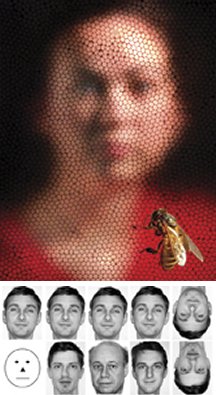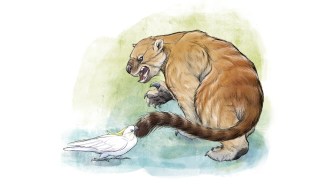Honeybees will learn to zoom up to particular human faces in a version of a facial-recognition test used for people, researchers say.

Previous studies of bee vision failed to show that the insects could distinguish such subtle patterns, says Adrian Dyer of Johannes Gutenberg University in Mainz, Germany. The new evidence suggests that face recognition doesn’t require a big brain, he and his colleagues propose in the Dec. 15 Journal of Experimental Biology.
Researchers who study face recognition among mammals point out that the bees’ feat falls far short of human powers. However, Jon Peirce of the University of Nottingham in England says of the bee test, “Just viewed as pattern recognition, it’s still a remarkably hard task.”
Face recognition by people has inspired lively research in recent years (SN: 7/7/01, p. 10: Faces of Perception). A team including Peirce announced in 2001 that sheep can remember sheep faces for years. Other researchers have shown that various primates and paper wasps (SN: 6/29/02, p. 405: Available to subscribers at Wasp Painting: Do insects know each other’s faces?) recognize familiar faces in their own species.
Dyer, who studies bee and human vision, wondered whether an animal that had faced no evolutionary pressure to distinguish among people could recognize human faces. “I thought it was a long shot,” he says.
He and his colleagues fastened a portrait above each of four feeders that dispensed either a bee-favorite sugar solution or a solution tainted with quinine, which bees disdain. The researchers borrowed some black-and-white portraits of men’s faces from a standard test used to diagnose people with cognitive deficits.
The researchers put the bees through a multistep education in picking out a photo of a beardless young man. They put his picture above two of the sugar feeders and placed images of another face above the two quinine feeders. Between trials, the researchers shuffled the positions of the pictures and the solutions, keeping the sweet flavor with the one man’s photo.
After one trial with a stylized face and another with an unfamiliar photo above the quinine solution, a bee had learned to fly to the first man’s photo most of the time. The researchers then switched the unfamiliar photos, emptied all the feeders, and positioned the photos. As long as the photos were upright, the bees picked out the original fellow’s face at least 80 percent of the time.
Nancy Kanwisher of the Massachusetts Institute of Technology, who studies face recognition by people, argues that the bee test examines pattern recognition rather than face recognition per se. “If the bees had been tested for generalizing slightly different images of the same person, with a different emotional expression, direction of eye gaze, hair position, or even just a different image size, that would be more impressive,” she says. Face recognition by people represents “a much harder version of the task,” she adds.







